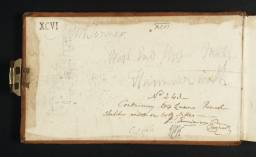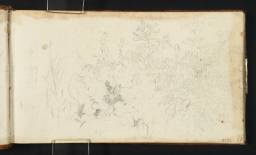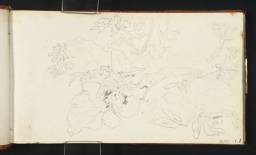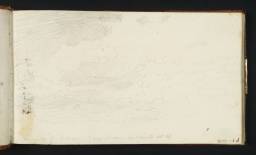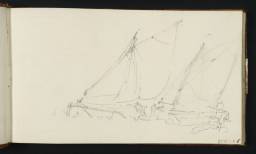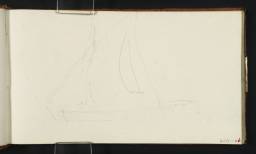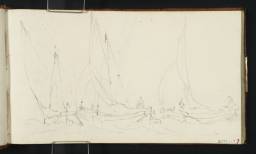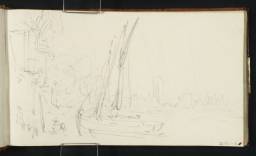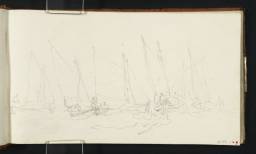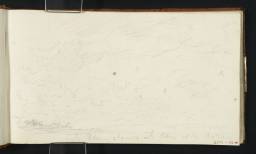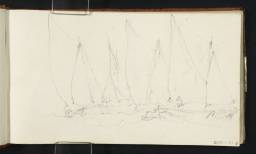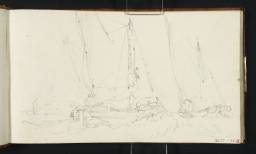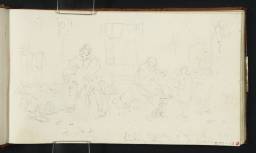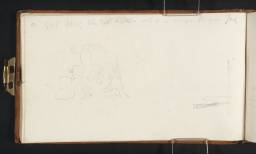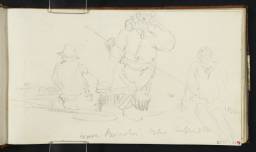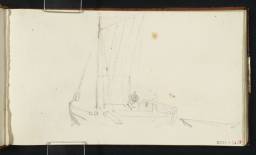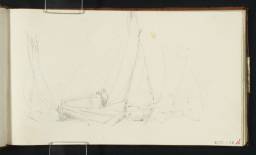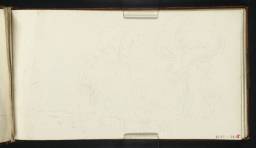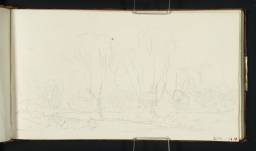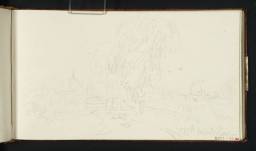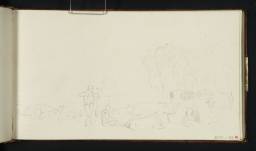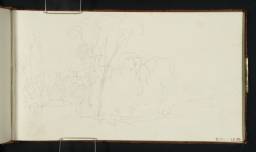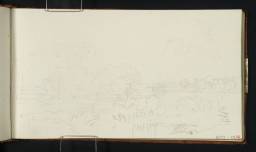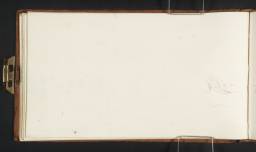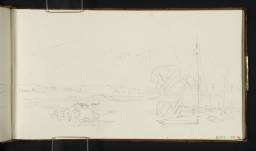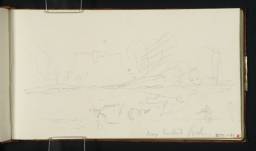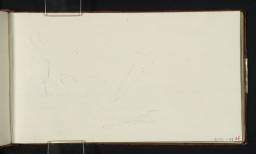Turner Bequest XCVI
Pocket book, bound in calf, with one brass clasp
75 leaves of white laid writing paper made on a single-faced mould
Approximate page size 92 x 163 mm
Made by George Stafford at Apsley Mill, Hertfordshire, and watermarked with the figure of Britannia and countermarked ‘GS | 1806’
Inscribed by Turner in ink ‘21. River’ on a label on the spine (D40654) and in pencil ‘J.M.W. Turner | West End, Upper Mall, | Hammersmith’ inside front cover (D40650)
Endorsed by the Executors of the Turner Bequest in ink ‘No.243 – | Containing 64 leaves. Pencil | sketches, most on both sides’, and signed by Henry Scott Trimmer and Charles Turner in ink ‘H.S. Trimmer’, ‘C. Turner’ and by John Prescott Knight and Charles Lock Eastlake in pencil ‘JPK’ and ‘C.L.E.’, all inside front cover. A further endorsement by John Ruskin is recorded by Finberg: ‘243. Early. Good for distribution’
75 leaves of white laid writing paper made on a single-faced mould
Approximate page size 92 x 163 mm
Made by George Stafford at Apsley Mill, Hertfordshire, and watermarked with the figure of Britannia and countermarked ‘GS | 1806’
Inscribed by Turner in ink ‘21. River’ on a label on the spine (D40654) and in pencil ‘J.M.W. Turner | West End, Upper Mall, | Hammersmith’ inside front cover (D40650)
Endorsed by the Executors of the Turner Bequest in ink ‘No.243 – | Containing 64 leaves. Pencil | sketches, most on both sides’, and signed by Henry Scott Trimmer and Charles Turner in ink ‘H.S. Trimmer’, ‘C. Turner’ and by John Prescott Knight and Charles Lock Eastlake in pencil ‘JPK’ and ‘C.L.E.’, all inside front cover. A further endorsement by John Ruskin is recorded by Finberg: ‘243. Early. Good for distribution’
Accepted by the nation as part of the Turner Bequest 1856
Exhibition history
References
This sketchbook belongs to the group used on or near the Thames from circa 1805. It contains pencil sketches of the river at such places as Twickenham, Walton Bridges, Laleham and Penton Hook but also perhaps east of London, with sailing barges in open, choppy water. There are views of the Grand Union Canal and sketches of barges and bargemen, agricultural workers, cottages, horses and cattle. Subjects in Hertfordshire include Cassiobury Park near Watford and Moor Park near Rickmansworth. There are also passages of Turner’s verse. The address written by Turner inside the front cover is that of 6 West End, Hammersmith, off Hammersmith Terrace, used by him from the autumn of 1806. A very slight pencil sketch of a house or villa, drawn sideways near the address, might represent this building, long since demolished, but could also be an early idea for his next Thames-side house, Sandycombe Lodge at Twickenham. He left Hammersmith by late 1811 but this sketchbook dates from early in his residence there. He visited Cassiobury in 1807, and Finberg was probably correct in his guess that the book dates from around that year as there are also subjects related to pictures exhibited in 1808.
Turner’s recent visit to Cassiobury was noted by Joseph Farington on 15 November 1807.1 For the estate, its owner the 5th Earl of Essex and other drawings made there, see Sketchbooks and Drawings Connected with Cassiobury Park and Harvest Pictures for the Earl of Essex circa 1807–12, and especially Tate D05373; Turner Bequest LXXXVI 17a for a sketch of the house across fields similar to the views in this sketchbook, folios 46, 61 verso–62 verso, 63 verso, 64 verso, 65 verso (D06017, D06040–D06042, D06044, D06046, D06048). Turner was at Cassiobury at harvest time and haymaking scenes on folios 66 verso, 67 verso and 71 verso (D06050, D06052, D06058) were probably drawn there. Collectively, they seem to be related to the unfinished painting Cassiobury Park: Reaping (Tate N04663)2 but cannot be described as studies for it.
Moor Park is not far from Cassiobury and Turner must have seen it on the same trip; his view on folio 49 (D06071) is from the Grand Union Canal, which passes through the grounds of Cassiobury, and the canal boats and boatmen in the sketchbook were probably drawn on the canal. Quite possibly Turner took a trip on the canal, which had only recently opened and joined the Thames at Brentford. Later, Turner used his sketch for the watercolour, More Park, near Watford, on the River Colne made for his series of Rivers of England (Tate D18141; Turner Bequest CCVIII H).
The pony on folio 45 verso (D06016) has been connected by both Finberg and Butlin and Joll with the one Turner painted in The Forest of Bere, exhibited in Turner’s Gallery 1808 (Tate T03875; displayed at Petworth House).3 This picture depicts scenery near Havant that Turner passed through on a visit to Portsmouth late in 18074 and reflects the concern with rural activity and tendency to naturalism encouraged by his stays beside the Thames. From his boat or in his garden he sketched outdoors and he painted in the summer-house of the Hammersmith house. As this sketchbook was clearly used there and consulted for Cassiobury Park: Reaping and The Forest of Bere, it is conceivable that these pictures were painted there rather than in his London studio.
The most direct connection with a picture is between folio 45 (D06015) and Pope’s Villa at Twickenham, During its Dilapidation also exhibited in Turner’s Gallery 1808 (on the London art market in 2008).5 Perhaps this picture, too, was painted or begun at Hammersmith. Pope’s Villa was Turner’s response to the demolition, in 1807, of the poet Alexander Pope’s house on the orders of Baroness Howe, who replaced it with another house.6 Turner used the sketch in this book, made on the spot, and even adopted the fallen tree in the foreground to symbolise a famous willow planted by Pope, which had been blown down in a storm. Long passages of Turner’s own poetry occupying later folios of the book are also concerned with the demolition, which affected him deeply, and must be early drafts for his poem ‘On the Demolition of Pope-House at Twickenham’ in his Verse Book (private collection).7 They were presumably written as Turner worked on the picture, 1807–8. In so far as the destruction of the house typified cultural neglect, they also find counterparts in a manuscript poem, discovered by Jerrold Ziff among Turner’s papers in the British Library, lamenting the sufferings of the artist in a philistine and materialistic country.8 If the house sketched inside the front cover of the sketchbook is an early idea for Sandycombe, it would reinforce Patrick Youngblood’s suggestion, based on the poetry, that Turner built it to ‘perpetuate the memory of Pope’s villa symbolically’.9
The sketches are mostly quite slight, the exceptions being sky studies, which are more
carefully drawn and inscribed with notes on colour and effect.
carefully drawn and inscribed with notes on colour and effect.
As Gerald Wilkinson observes, the themes of this sketchbook, especially the agricultural scenes, barges, boats and views of the Thames, are maintained in the Windsor and Eton sketchbook (Tate D06072–D06179; D40655–D40658; Turner Bequest XCVII) which must have been in use for several years from 1806 and may contain views of Hammersmith.
See the Spithead sketchbook (Tate D06518–D06617; D06716–D06719; D40605–D40615; D40732; D41428–D41430; D41495; Turner Bequest C).
Technical notes
How to cite
David Blayney Brown, ‘River sketchbook c.1806–8’, sketchbook, August 2008, in David Blayney Brown (ed.), J.M.W. Turner: Sketchbooks, Drawings and Watercolours, Tate Research Publication, December 2012, https://www

